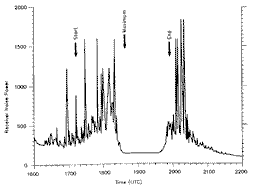 |
Science Frontiers ONLINE No. 98: Mar-Apr 1995 |
|
|
A Yagi Watches A Solar Eclipse
During the partial solar eclipse of July 11, 1991, D. Emerson had his Yagi antenna pointed in the direction of the phenomenon. His receiver was tuned to 145.8 MHz. The sun is always emitting radio noise, and one would expect that the moon passing in front of the sun would gradually cut off most, but not all, of the radio noise picked up by the antenna and, after the eclipse's midpoint, the noise would increase back to normal levels. Instead of the expected:
 Radio noise power measured during a partial solar eclipse. The arrows indicate the stages of the eclipse |
"There was no radio evidence of any effect of the solar eclipse until 1822 UTC, 58 minutes after the start of the eclipse. At that point, all detectable solar emission disappeared within the space of about nine minutes. The emission did not start to reappear until 72 minutes later, at 1943 UTC, and was fully restored by 1951 UTC, 13 minutes before the end of the eclipse, which occurred at 2004 UTC."The fact that radio emission disappeared and reappeared fairly abruptly part way through the eclipse indicates that most of the radio emission was occurring from one discrete point on the sun's surface rather than from the entire solar disc."
(Emerson, Darrel; "Radio Observations of Two Solar Eclipses," QST, p. 21, February 1995. Cr. L.M. Nash)
Question. What was happening at this small region of the sun's surface?